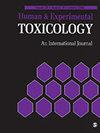Sulforaphane triggers Sirtuin 3-mediated ferroptosis in colorectal cancer cells via activating the adenosine 5‘-monophosphate (AMP)-activated protein kinase/ mechanistic target of rapamycin signaling pathway
IF 2.7
4区 医学
Q3 TOXICOLOGY
引用次数: 0
Abstract
ObjectiveThis study aimed to explore the expression and biological functions of SIRT3 in colorectal cancer cells (HCT-116), the impacts of sulforaphane on the ferroptosis of HCT-116 cells and the involvement of the SIRT3/AMPK/mTOR axis in those effects.MethodsSIRT3-overexpressing (OE) and SIRT3-knockout (KO) cell lines were treated with different concentrations of sulforaphane, RSL-3, and IKE. Cell viability, intracellular ROS, MDA, iron levels, as well as mRNA and protein expressions of target genes were measured.ResultsSIRT3 expression in HCT-116 cells was increased by ferroptosis inducers and decreased by ferroptosis inhibitors. SIRT3 overexpression reduced cell viability and increased intracellular levels of ROS, MDA, and iron, whereas SIRT3 knockdown achieved the opposite effects. SIRT3 overexpression suppressed SLC7A11 expression and promoted the activation of AMPK/mTOR pathway. Restoration of SLC7A11 expression blocked the effects of SIRT3 on ferroptosis induction and cell viability inhibition. SIRT3 effects on cell viability and ferroptosis were antagonized by inhibitors of AMPK or mTOR. Moreover, sulforaphane triggered the ferroptosis of HCT-116 cells by activating the SIRT3/AMPK/mTOR axis.ConclusionsSIRT3 triggered SLC7A11-mediated ferroptosis in HCT-116 cells, reducing cell viability by activating the AMPK/mTOR pathway, and sulforaphane targets it to inhibit colorectal cancer.红豆杉通过激活 5'-单磷酸腺苷(AMP)激活的蛋白激酶/雷帕霉素机制靶点信号通路,触发 Sirtuin 3 介导的结直肠癌细胞铁变态反应
目的 本研究旨在探讨SIRT3在结直肠癌细胞(HCT-116)中的表达和生物学功能、红景天对HCT-116细胞铁变态反应的影响以及SIRT3/AMPK/mTOR轴在这些影响中的参与作用。方法 用不同浓度的红景天、RSL-3和IKE处理SIRT3高表达(OE)和SIRT3基因敲除(KO)细胞系。结果SIRT3在HCT-116细胞中的表达在铁色素沉着诱导剂的作用下增加,在铁色素沉着抑制剂的作用下减少。SIRT3 的过表达降低了细胞活力,增加了细胞内 ROS、MDA 和铁的水平,而 SIRT3 的敲除则产生了相反的效果。SIRT3 的过表达抑制了 SLC7A11 的表达,促进了 AMPK/mTOR 通路的激活。恢复 SLC7A11 的表达阻断了 SIRT3 诱导铁变态反应和抑制细胞活力的作用。AMPK 或 mTOR 抑制剂可拮抗 SIRT3 对细胞活力和铁突变的影响。结论SIRT3通过激活AMPK/mTOR通路触发了SLC7A11介导的HCT-116细胞铁蛋白沉降,降低了细胞活力,而莱菔硫烷则以其为靶点抑制结直肠癌。
本文章由计算机程序翻译,如有差异,请以英文原文为准。
求助全文
约1分钟内获得全文
求助全文
来源期刊
CiteScore
5.70
自引率
3.60%
发文量
128
审稿时长
2.3 months
期刊介绍:
Human and Experimental Toxicology (HET), an international peer reviewed journal, is dedicated to publishing preclinical and clinical original research papers and in-depth reviews that comprehensively cover studies of functional, biochemical and structural disorders in toxicology. The principal aim of the HET is to publish timely high impact hypothesis driven scholarly work with an international scope. The journal publishes on: Structural, functional, biochemical, and molecular effects of toxic agents; Studies that address mechanisms/modes of toxicity; Safety evaluation of novel chemical, biotechnologically-derived products, and nanomaterials for human health assessment including statistical and mechanism-based approaches; Novel methods or approaches to research on animal and human tissues (medical and veterinary patients) investigating functional, biochemical and structural disorder; in vitro techniques, particularly those supporting alternative methods

 求助内容:
求助内容: 应助结果提醒方式:
应助结果提醒方式:


